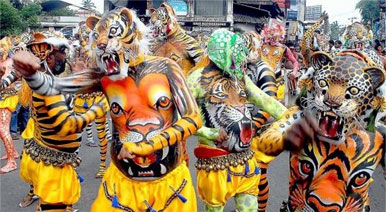Onam is a major festival celebrated in the Indian state of Kerala. It usually falls in August or September and marks the homecoming of the legendary King Mahabali. The festival is known for its vibrant and colorful celebrations, which include a variety of cultural activities, traditional meals, and elaborate decorations.

After three months of heavy rains, the sky becomes clear blue and the forests a deep green. The brooks and streams come alive, spitting forth-gentle white foam, the lakes and rivers overflow, and lotuses and lilies are in full bloom. It is time to reap the harvest, to celebrate and to rejoice. The harvest festival of Onam corresponds with the Malayalam New Year, Chingam.
Here are some key aspects of Onam:
1. Pookkalam (Flower Rangoli):
A beautiful floral arrangement made at the entrance of homes, often featuring intricate patterns and vibrant colors. The flowers used are typically seasonal and locally sourced.
2. Onasadya (Traditional Feast):
A grand vegetarian meal served on banana leaves, consisting of a variety of dishes such as rice, sambar, avial, thoran, and payasam. It’s a central part of the Onam celebrations.
3. Vallamkali (Boat Race):
One of the most exciting events of Onam, the snake boat races are held on the backwaters of Kerala. Teams from different villages compete in a thrilling and colorful race.
4. Onam Ponnada (Traditional Attire):
People wear traditional Kerala attire, which includes the Kasavu saree for women and mundu for men.
5. Onam Games and Performances:
Various traditional games and cultural performances take place, including Kathakali dance, Pulikali (tiger dance), and various folk arts.
6. Onam Sadhya (Celebration Meal):
The Onam Sadya is a multi-course feast that reflects the rich culinary traditions of Kerala. It’s a communal event where families and friends gather to enjoy the meal together.
7. Mahabali's Visit:
According to legend, King Mahabali visits Kerala during Onam to see his people and bless them.
Onam is a celebration of Ten days. People put flower mats in front of their houses, to welcome the King Mahabali. There is competition for the laying of flower mats; Keralites all over the world celebrate these ten days with pomp and gaiety. They wear new dresses, visits almost all the temples they can, performs lot of dances like Thiruvathira kali and Thumbi Tullal and the most important thing is the grant lunch they have on the Thiuruvonam day which is also called the Fourth Onam. People of Kerela never miss the Grant lunch. A saying in Malayalam quotes "Kanam Vittu Onam Unnanam" which means "We should have the Thiruonam lunch even if we have to sell all our properties". They give that much importance to the lunch on the Thiruonam day.
Here’s a detailed look at how Onam is celebrated:
1. Preparations Before Onam
-
Cleaning and Decorating Homes: People clean their homes thoroughly and decorate their surroundings with traditional Onam motifs. They set up Pookkalam (flower carpets) at the entrance of their homes.
-
Shopping: Families buy new clothes, gifts, and ingredients for the Onam Sadya (feast). The Kasavu saree for women and mundu for men are popular choices for the festival attire.
2. Onam Day Celebrations
-
Early Morning Rituals: The festival begins with a special pooja (prayer) to welcome King Mahabali. Many families visit temples to participate in the rituals and offer prayers for prosperity and happiness.
-
Pookkalam Creation: A significant part of the celebration involves creating intricate flower designs at the entrance of homes. The Pookkalam is made with a variety of colorful flowers, arranged in patterns that are often reflective of the spirit of Onam.
-
Wearing New Clothes: Onam is a time for wearing traditional attire. Women often wear the Kasavu saree, which is a white saree with a golden border, while men wear the traditional mundu.
3. Onasadya (The Feast)
-
Preparing the Sadya: The Onasadya is a grand vegetarian feast served on a banana leaf. It includes a variety of dishes such as rice, sambar, avial, thoran, kichadi, and a sweet dish like payasam. The meal is traditionally eaten with the right hand, sitting on the floor.
-
Sharing the Meal: Families and friends gather to enjoy the Sadya together. It’s a communal activity that symbolizes unity and togetherness.
4. Traditional Performances and Activities
-
Vallamkali (Boat Races): This exciting boat race, featuring long, narrow boats decorated like snakes, takes place on the backwaters of Kerala. The race is a major highlight of the Onam celebrations and draws large crowds.
-
Pulikali (Tiger Dance): In this colorful dance form, performers paint themselves to look like tigers and dance to traditional music. It’s a festive and lively performance that adds to the celebratory atmosphere.
-
Kathakali and Mohiniyattam: Traditional dance forms such as Kathakali (a classical dance-drama) and Mohiniyattam (a graceful classical dance performed by women) are performed to showcase Kerala’s rich cultural heritage.
-
Onam Games: Traditional games and activities, including Uriyadi (breaking pots filled with goodies) and Kummi (a group dance), are enjoyed by people of all ages.
5. Community and Social Gatherings
-
Family Reunions: Onam is a time for families to come together. Many people travel from different parts of the country or world to celebrate with their loved ones.
-
Charitable Acts: It’s also a time for giving and sharing. Many people participate in charitable activities, donate to the less fortunate, and engage in community service.
6. Post-Onam Activities
-
Farewell to Mahabali: On the last day of Onam, a special ritual is held to bid farewell to King Mahabali. This is often accompanied by a feeling of nostalgia as people anticipate his return next year.
The celebration of Onam reflects Kerala’s cultural richness and communal harmony, making it one of the most cherished festivals in the state.
Also Read: Images That Captures The Grand Cultural Extravaganza of Onam Festival